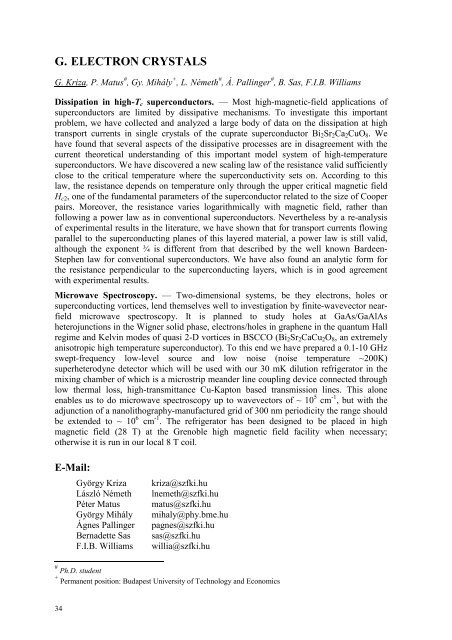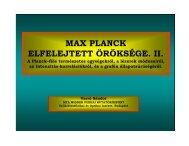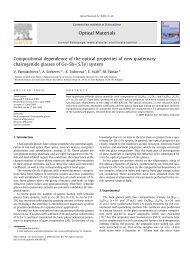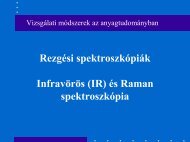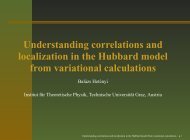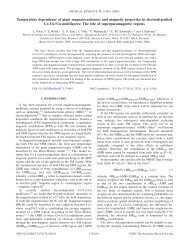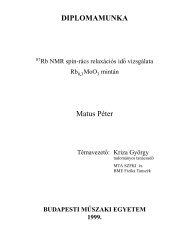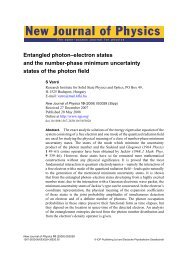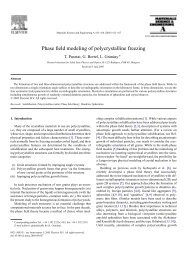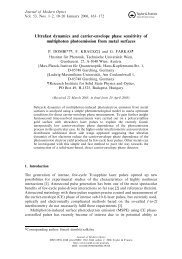ANNUAL REPORT - MTA SzFKI
ANNUAL REPORT - MTA SzFKI
ANNUAL REPORT - MTA SzFKI
Create successful ePaper yourself
Turn your PDF publications into a flip-book with our unique Google optimized e-Paper software.
G. ELECTRON CRYSTALS<br />
G. Kriza, P. Matus # , Gy. Mihály + , L. Németh # , Á. Pallinger # , B. Sas, F.I.B. Williams<br />
Dissipation in high-T c superconductors. — Most high-magnetic-field applications of<br />
superconductors are limited by dissipative mechanisms. To investigate this important<br />
problem, we have collected and analyzed a large body of data on the dissipation at high<br />
transport currents in single crystals of the cuprate superconductor Bi 2 Sr 2 Ca 2 CuO 8 . We<br />
have found that several aspects of the dissipative processes are in disagreement with the<br />
current theoretical understanding of this important model system of high-temperature<br />
superconductors. We have discovered a new scaling law of the resistance valid sufficiently<br />
close to the critical temperature where the superconductivity sets on. According to this<br />
law, the resistance depends on temperature only through the upper critical magnetic field<br />
H c2 , one of the fundamental parameters of the superconductor related to the size of Cooper<br />
pairs. Moreover, the resistance varies logarithmically with magnetic field, rather than<br />
following a power law as in conventional superconductors. Nevertheless by a re-analysis<br />
of experimental results in the literature, we have shown that for transport currents flowing<br />
parallel to the superconducting planes of this layered material, a power law is still valid,<br />
although the exponent ¾ is different from that described by the well known Bardeen-<br />
Stephen law for conventional superconductors. We have also found an analytic form for<br />
the resistance perpendicular to the superconducting layers, which is in good agreement<br />
with experimental results.<br />
Microwave Spectroscopy. — Two-dimensional systems, be they electrons, holes or<br />
superconducting vortices, lend themselves well to investigation by finite-wavevector nearfield<br />
microwave spectroscopy. It is planned to study holes at GaAs/GaAlAs<br />
heterojunctions in the Wigner solid phase, electrons/holes in graphene in the quantum Hall<br />
regime and Kelvin modes of quasi 2-D vortices in BSCCO (Bi 2 Sr 2 CaCu 2 O 8 , an extremely<br />
anisotropic high temperature superconductor). To this end we have prepared a 0.1-10 GHz<br />
swept-frequency low-level source and low noise (noise temperature ~200K)<br />
superheterodyne detector which will be used with our 30 mK dilution refrigerator in the<br />
mixing chamber of which is a microstrip meander line coupling device connected through<br />
low thermal loss, high-transmittance Cu-Kapton based transmission lines. This alone<br />
enables us to do microwave spectroscopy up to wavevectors of ~ 10 5 cm -1 , but with the<br />
adjunction of a nanolithography-manufactured grid of 300 nm periodicity the range should<br />
be extended to ~ 10 6 cm -1 . The refrigerator has been designed to be placed in high<br />
magnetic field (28 T) at the Grenoble high magnetic field facility when necessary;<br />
otherwise it is run in our local 8 T coil.<br />
E-Mail:<br />
György Kriza<br />
László Németh<br />
Péter Matus<br />
György Mihály<br />
Ágnes Pallinger<br />
Bernadette Sas<br />
F.I.B. Williams<br />
kriza@szfki.hu<br />
lnemeth@szfki.hu<br />
matus@szfki.hu<br />
mihaly@phy.bme.hu<br />
pagnes@szfki.hu<br />
sas@szfki.hu<br />
willia@szfki.hu<br />
# Ph.D. student<br />
+ Permanent position: Budapest University of Technology and Economics<br />
34


